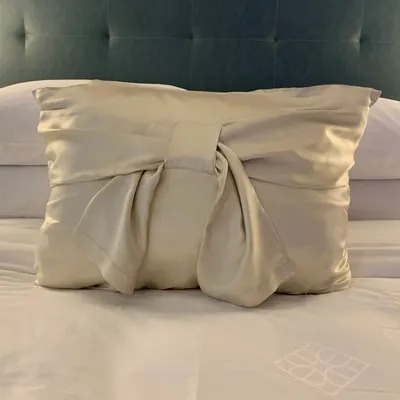Satin or Silk Pillowcase – Everything You Need to Know
Wondering what the difference is between a satin versus a silk pillowcase? We’re glad you asked because when it comes to your hair’s health, it’s always good to know the difference. Despite their similar textures and appearances, satin and silk aren’t the same. However, before you get stressed out trying to spot the difference, there’s one thing you need to know.
Both fabrics are superb choices for your hair and your sleep hygiene.
The difference amounts to a little more than personal preference, but it’s not as critical as how some might make it sound. We’re going to take a deep dive into the realm of fabrics to unravel the nature, origin, and physics of silk, satin, and some lookalikes you need to know to keep your hair in the fullest of its glory.
Silk, Satin, and Cotton
It’s no secret that cotton pillowcases aren’t great for your hair, especially if it’s thick or curly. The water-wicking properties which make it so wonderful for hair towels work against you when it comes to pillowcases. A cotton pillowcase, no matter how high the thread count, plus eight hours of sleep is a recipe for frizzy, tangled locks.
Enter satin and silk. Both of these fabrics create a smooth, slick surface that is much gentler for your hair. With satin and silk pillowcases:
- Your hair experiences less moisture loss. Unlike cotton, these fabrics don’t wick water. (That’s why you don’t see any silk hair towels on the market.)
- The friction between your hair and the pillowcase is decreased. A cotton pillowcase can be as damaging to your hair as a bath towel.
- Your hair (and skin) stay cleaner. Satin and silk don’t soak up oils, product, or anything else which might coat your hair or inspire a breakout.
There are many benefits of a silk or satin pillowcase. Why? Let’s look more closely at each.
What Is Silk?
Silk is a natural protein fiber traditionally produced by a few dozen types of insects around the world. Traditionally, only the silk of silkworms has ever been harvested for textiles. It was first developed in ancient China around 8,500 years ago, and by 1100 BCE Chinese silk was found in Egypt. The Chinese guarded their trade secrets so well that the Europeans didn’t figure out how to make silk for another 1,600 years. By the Middle Ages, however, it was one of the most sought-after fabrics in existence.
Silk has been associated with luxury since the start. Today, real silk still commands significant prices. Like quality cotton, silk takes more skill and effort to weave into a textile. Also, like cotton, manufacturers will sometimes mix other types of fabrics with the silk fibers to reduce the price but maintain the texture of the material. Be careful with this because it can affect the absorbency, hypo-allergenic properties, and frictionless texture which make silk so valuable as a pillowcase.
Silk vs. Satin
Pillowcases which exhibit a glossy surface and the sleekness of silk – but aren’t silk – are known collectively as satin. Satin is technically a type of weaving rather than a type of fabric. Although satin was traditionally made from silk, today it’s not uncommon to find satins made from a variety of synthetic fibers including polyester, rayon, acetate, and cotton.
The ability to create satin from synthetic fabrics means that it’s often much more flexible and supple than real silk. This makes it an attractive material for things like lingerie because of the way it drapes the figure. As a pillowcase, satin is much more likely to move with your movements so that your hair rubs against the surface much less.
A Word of Caution About Sateen
Despite the similarities between the words, sateen is not the same as satin. Like satin, sateen is created from a weave related to the satin weave. However, whereas satin is often a synthetic fiber, sateen is usually woven using cotton. The sateen weave is one of the ways cotton manufacturers produce bed sheets which are smooth and silky but don’t come with the price tag of high thread count cotton.
Sateen is incredibly common in the world of bed linens. Despite its appearance, it can still visit damage upon your hair because it retains cotton’s water-wicking properties. Don’t be fooled.
Advantages of Silk Over Satin
Silk and satin are both great choices for pillowcases, but each fabric has its own distinct advantages. Many people prefer silk because:
- It breathes. Your head and hair won’t get smothered or overheated.
- It’s hypoallergenic. It’s naturally resistant to fungus, mold, mites, and allergens.
- It doesn’t involve synthetic materials. It’s a natural fiber, for those who wish to keep their beauty routine au naturel.
- It might help with your complexion. Got acne? Try a silk pillowcase and see if that doesn’t help it clear.
If you wish to repose in pure luxury, then silk is the way to go. Your hair, skin, and inner natural beauty will thank you for it.
Advantages of Satin Over Silk
If the sheer price tag and opulence of real silk makes you nervous, fear not! When it comes to your hair, satin produces the same desirable effects plus other advantages which make it convenient. Satin is:
- It typically costs a third to half the price of silk.
- More readily available. Since satin is created from common materials like polyester, it’s much easier to find it.
- Easier to clean. You can throw a satin pillowcase into the wash with the rest of your laundry.
- It might be softer. You might actually prefer the feel of satin because it tends to be silkier than real silk.
Choose satin when you want the advantages of silk plus the modern conveniences afforded by synthetic fiber.
Start Your Night Off Right with a Satin Pillowcase
Hopefully, we’ve helped you simplify the choice of a satin versus a silk pillowcase. Both fabrics have their unique advantages, and both are excellent choices for keeping your hair in pristine condition at all times.
You’ve got your beauty routine down to a science, and you’ve got a dedicated hair towel. All you need is a satin pillowcase to take your beauty sleep to the next level.
Say goodbye to bad hair days and hello to luxurious nights.

